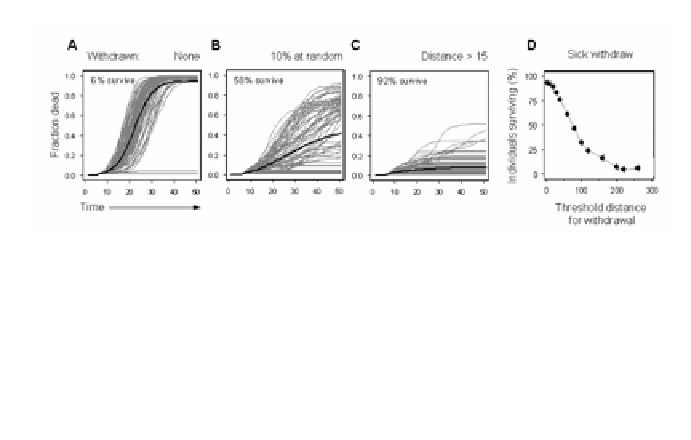Biomedical Engineering Reference
In-Depth Information
Figure 5
.
Sickness behavior
. When sick individuals withdraw from even a small number of social
contacts (10% in
B
), mortality rates decline substantially in highly vulnerable population structures
such as this small-world network (compare to 0% withdrawal in
A
). If the same number of voluntary
withdrawals is selectively deployed toward distant contacts (
C
), population protection is even greater.
Considerable population survival benefits accrue even if individuals maintain contact with large
number of individuals in their vicinity (supporting survival of the afflicted) and defer contact only
with quite distant interaction partners (
D
).
emerges from a biologically impacted person who tracks (is) the source of infec-
tion, rather than depending upon the simultaneous conscientiousness of many
potential targets who face an unrealized threat. Interestingly, sick people are
more likely to defer contact with strangers or low-frequency partners than they
are to avoid their core social contacts (especially family). From an evolutionary
perspective, this would seem to set our closest genetic relatives at a competitive
disadvantage. However, it also prevents large jumps of disease through social
space, and thus efficiently protects the population as a whole. Figure 5C illus-
trates the comparative advantage of redeploying social contacts away from so-
cially distant partners during times of illness. The same number of links is
withdrawn in Figures 5B and 5C. The only difference involves making the prob-
ability of withdrawal depend upon social distance in 5C. Distance-dependent
contact reduction confers major population survival benefits, even when reduc-
tions are limited to very distant interaction partners (shown parametrically in
Figure 5D). Such results imply there may be considerable selective pressure for
biological mechanisms that reduce social contact during sickness. All simula-
tions in Figure 5 were conducted in a small-world network of 1000 agents, each
realizing a single randomly selected contact per unit time from a set of possible
contacts that vary from 1 to 10 according to a power law. The pathogen is infec-
tious for 1 time unit before a stricken individual feels ill and another 3 time units
subsequently, and each of the 300 hosts has a resistance of .5 (1 = 100% prob-
ability of infection given exposure). Disease easily penetrates the nonreactive
small world of Figure 5A to kill an average 94% of the population within 50
time units. Even a small (10%) reduction in social contact rates by sickened in-
dividuals can increase survival frequencies by about tenfold (5B), and these pro-

